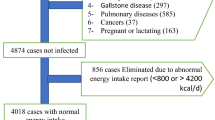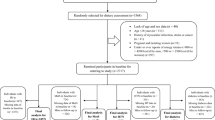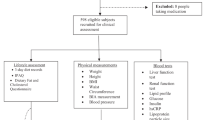Abstract
Background/Objectives:
Diets with a high postprandial glycaemic response may contribute to the long-term development of insulin resistance and diabetes; however, earlier epidemiological studies are conflicting on whether glycaemic index (GI) or glycaemic load (GL) are dietary factors associated with the progression. Our objectives were to estimate GI and GL in a group of older women, and evaluate cross-sectional associations with insulin resistance.
Subjects/Methods:
The subjects were 329 Australian women aged 42–81 years participating in year 3 of the Longitudinal Assessment of Ageing in Women study. Dietary intakes were assessed by diet history interviews and analysed using a customized GI database. Insulin resistance was defined as a homeostasis model assessment value of >3.99, based on fasting blood glucose and insulin concentrations.
Results:
GL was significantly higher in the 26 subjects who were classified as insulin resistant compared with subjects who were not (134±33 versus 114±24, P<0.001). In a logistic regression model, an increment of 15 GL units increased the odds of insulin resistance by 2.09 (95% confidence interval (1.55, 2.80), P<0.001) independently of potential confounding variables. No significant associations were found when insulin resistance was assessed as a continuous variable.
Conclusions:
The results of this cross-sectional study support the concept that diets with a higher GL are associated with an increased risk of insulin resistance. Further studies are required to determine whether reducing the glycaemic intake, either by consuming lower GI foods or through smaller serves of carbohydrate, can contribute to a reduction in development of insulin resistance and long-term risk of type II diabetes.
This is a preview of subscription content, access via your institution
Access options
Subscribe to this journal
Receive 12 print issues and online access
$259.00 per year
only $21.58 per issue
Buy this article
- Purchase on Springer Link
- Instant access to full article PDF
Prices may be subject to local taxes which are calculated during checkout

Similar content being viewed by others
References
Ascaso J, Romero P, Real J, Priego A, Valldecabres C, Carmena R (2001). Insulin resistance quantification by fasting insulin plasma values and HOMA index in non diabetic subjects. Med Clin 117, 530–533.
Augustin LS, Franceschi S, Jenkins DJ, Kendall CW, La Vecchia C (2002). Glycemic index in chronic disease: a review. Euro J Clin Nutr 56, 1049–1071.
Barclay AW, Brand-Miller JC, Wolever TMS (2005). Glycemic index, glycemic load, and glycemic response are not the same. Diabetes Care 28, 1839–1840.
Barclay AW, Petocz P, McMillan-Price J, Flood VM, Prvan T, Mitchell P et al. (2008). Glycemic index, glycemic load, and chronic disease risk- a meta-analysis of observational studies. Am J Clin Nutr 87, 627–637.
Barr E, Magliano D, Zimmet P, Polkinghorne K, Atkins R, Dunstan D et al. (2006). AusDiab 2005—The Australian Diabetes, Obesity and Lifestyle Study: Followup Report. International Diabetes Institute: Melbourne.
Black AE (2000). The sensitivity and specificity of the Goldberg cut-off for EI: BMR for identifying diet reports of poor validity. Euro J Clin Nutr 54, 395–404.
Buyken A, Liese A (2005). Dietary glycemic index, glycemic load, fiber, simple sugars, and insulin resistance: the Inter99 Study: response to Lau et al. Diabetes Care 28, 2986.
Cameron M, Van Staveren W (eds) (1988). Manual on Methodology for Food Consumption Studies. Oxford University Press: New York.
Ceriello A, Bortolotti N, Crescentini A, Motz E, Lizzio S, Russo A et al. (1998). Antioxidant defences are reduced during the oral glucose tolerance test in normal and non-insulin-dependent diabetic subjects. Euro J Clin Invest 28, 329–333.
Cooney GJ, Storlien LH (1994). Insulin action, thermogenesis and obesity. Clin Endocr Metab 8, 481–507.
Dunstan DW, Zimmet PZ, Welborn TA, de Courten MP, Cameron AJ, Sicree RA et al. (2002). The rising prevalence of diabetes and impaired glucose tolerance: The Australian diabetes, obesity and lifestyle study. Diabetes Care 25, 829–834.
Foster-Powell K, Holt S, Brand-Miller J (2002). International table of glycemic index and glycemic load values: 2002. Am J Clin Nutr 76, 5–56.
Gibson R (1993). Nutritional Assessment: A Laboratory Manual. Oxford University Press: New York.
Hedblad B, Nilsson P, Janzon L, Berglund G (2000). Relation between insulin resistance and carotid intima-media thickness and stenosis in non-diabetic subjects. Results from a cross-sectional study in Malmö, Sweden. Diabet Med 17, 299–307.
Hirvensalo M, Lintunen T, Rantanen T (2000). The continuity of physical activity—a retrospective and prospective study among older people. Scand J Med Sci Sports 10, 37–41.
Hodge AM, English DR, O'Dea K, Giles GG (2004). Glycemic index and dietary fiber and the risk of type 2 diabetes. Diabetes Care 27, 2701–2706.
Holt SH, Miller JCB, Petocz P (1997). An insulin index of foods: The insulin demand generated by 1000-kj portions of common foods. Am J Clin Nutr 66, 1264–1276.
Hu FB, van Dam RM, Liu S (2001). Diet and risk of type II diabetes: the role of types of fat and carbohydrate. Diabetologia 44, 805–817.
Jenkins DJ, Wolever TM, Taylor RH, Barker H, Fielden H, Baldwin JM et al. (1981). Glycemic index of foods: a physiological basis for carbohydrate exchange. Am J Clin Nutr 34, 362–366.
Kahn SE (2003). The relative contributions of insulin resistance and beta-cell dysfunction to the pathophysiology of type 2 diabetes. Diabetologia 46, 3–19.
Khoo SK, O'Neill S, Travers C, Oldenburg B, the LAW Study Group (2008). Age-related changes relevant to health in women: design, recruitment, and retention strategies for the Longitudinal Assessment of Women (LAW) study. J Women's Health 17, 135–146.
Lau C, Færch K, Glümer C, Tetens I, Pedersen O, Carstensen B et al. (2005). Dietary glycemic index, glycemic load, fiber, simple sugars, and insulin resistance: the Inter99 study. Diabetes Care 28, 1397–1403.
Lebovitz H (2001). Insulin resistance: definition and consequences. Exp Clin Endocrinol Diabetes 109, S135–S148.
Liese A, Schulz M, Fang F, Wolever T, D'Agostino RJ, Sparks K et al. (2005). Dietary glycemic index and glycemic load, carbohydrate and fiber intake, and measures of insulin sensitivity, secretion, and adiposity in the Insulin Resistance Atherosclerosis Study. Diabetes Care 28, 2832–2838.
Marfella R, Quagliaro L, Nappo F, Ceriello A, Giugliano D (2001). Acute hyperglycemia induces an oxidative stress in healthy subjects. J Clin Invest 108, 635–636.
Martin B, Warram J, Krolewski A, Bergman R, Soeldner J, Kahn C (1992). Role of glucose and insulin resistance in development of type 2 diabetes mellitus: results of a 25-year follow-up study. Lancet 340, 925–929.
Matthews D, Hosker J, Rudenski A, Naylor B, Treacher D, Turner RC (1985). Homeostasis model assessment: insulin resistance and beta cell function from fasting plasma glucose and insulin concentrations in man. Diabetologia 28, 412–419.
McKeown NM, Meigs JB, Liu S, Saltzman E, Wilson PWF, Jacques PF (2004). Carbohydrate nutrition, insulin resistance, and the prevalence of the metabolic syndrome in the Framingham Offspring Cohort. Diabetes Care 27, 538–546.
Miles J (2008). A role for the glycemic index in preventing or treating diabetes? Am J Clin Nutr 87, 1–2.
Pan DA, Lillioja S, Kriketos AD, Milner MR, Baur LA, Bogardus C et al. (1997). Skeletal muscle triglyceride levels are inversely related to insulin action. Diabetes 46, 983–988.
Petersen KF, Shulman GI (2006). Etiology of insulin resistance. Am J Med 119, S10–S16.
Robertson RP (2004). Chronic oxidative stress as a central mechanism for glucose toxicity in pancreatic islet beta cells in diabetes. J Biol Chem 279, 42351–42354.
Sahyoun NR, Anderson AL, Tylavsky FA, Lee JS, Sellmeyer DE, Harris TB et al. (2008). Dietary glycemic index and glycemic load and the risk of type 2 diabetes in older adults. Am J Clin Nutr 87, 126–131.
Sempos CT (1992). Invited commentary: some limitations of semiquantitative food frequency questionnaires. Am J Epidemiol 135, 1127–1132.
Shulman GI (2000). Cellular mechanisms of insulin resistance. J Clin Invest 106, 171–176.
Stamler J, Vaccaro O, Neaton J, Wentworth D (1993). Diabetes, other risk factors, and 12-yr cardiovascular mortality for men screened in the Multiple Risk Factor Intervention Trial. Diabetes Care 16, 434–444.
Stern S, Williams K, Ferrannini E, Defronzo R, Bogardus C, Stern M (2005). Identification of individuals with insulin resistance using routine clinical measurements. Diabetes 54, 333–339.
Storlien L, Jenkins A, Chisholm D, Pascoe W, Khouri S, Kraegen E (1991). Influence of dietary fat composition on development of insulin resistance in rats. Relationship to muscle triglyceride and omega-3 fatty acids in muscle phospholipid. Diabetes 40, 280–289.
Tapsell LC, Brenninger V, Barnard J (2000). Applying conversation analysis to foster accurate reporting in the diet history interview. J Am Diet Assoc 100, 818–824.
University of Sydney (2007). Home of the Glycemic Index—GI Database online resource, accessed 2004–2007 (http://www.glycemicindex.com/).
Wahrenberg H, Hertel K, Leijonhufvud B-M, Persson L-G, Toft E, Arner P (2005). Use of waist circumference to predict insulin resistance: retrospective study. Br Med J 330, 1363–1364.
Weyer C, Bogardus C, Mott DM, Pratley RE (1999). The natural history of insulin secretory dysfunction and insulin resistance in the pathogenesis of type 2 diabetes mellitus. J Clin Invest 104, 787–794.
World Health Organisation (1999). Definition, Diagnosis and Classification of Diabetes Mellitus and Its Complications: Report of a WHO Consultation. World Health Organisation: Geneva.
Worthley L (ed) (2003). The Australian Short Course on Intensive Care Medicine. The Australasian Academy of Critical Care Medicine: Bedford Park, South Australia.
Zhang C, Liu S, Solomon CG, Hu FB (2006). Dietary fiber intake, dietary glycemic load, and the risk for gestational diabetes mellitus. Diabetes Care 29, 2223–2230.
Acknowledgements
We acknowledge the support provided by the Royal Women's Hospital Foundation, the affiliation with The University of Queensland and the sponsorship of the Betty Byrne Henderson Centre. We would like to thank LAW study coordinator Professor Soo Keat Khoo, LAW administration and clinical staff, and staff at Xyris Software for their assistance in dietary analysis. We are especially grateful to the LAW study women who generously donated their time to make this research possible.
Author information
Authors and Affiliations
Corresponding author
Additional information
Contributors: SO'N was involved in conception and design of the LAW study, and acquisition of data on insulin resistance and potential confounding variables. PLW and TO'S were involved in study conception and design. TO'S was involved in acquisition of dietary data and drafting of the paper. TO'S and AB analysed the data, and, together with PLW, were involved in interpretation of the data. All authors were involved in review of the paper.
Rights and permissions
About this article
Cite this article
O'Sullivan, T., Bremner, A., O'Neill, S. et al. Glycaemic load is associated with insulin resistance in older Australian women. Eur J Clin Nutr 64, 80–87 (2010). https://doi.org/10.1038/ejcn.2009.115
Received:
Revised:
Accepted:
Published:
Issue Date:
DOI: https://doi.org/10.1038/ejcn.2009.115
Keywords
This article is cited by
-
A case-control study of glycemic index, glycemic load and dietary fiber intake and risk of adenocarcinomas and squamous cell carcinomas of the esophagus: the Australian Cancer Study
BMC Cancer (2014)
-
Iron chelator alleviates tubulointerstitial fibrosis in diabetic nephropathy rats by inhibiting the expression of tenascinC and other correlation factors
Endocrine (2013)



